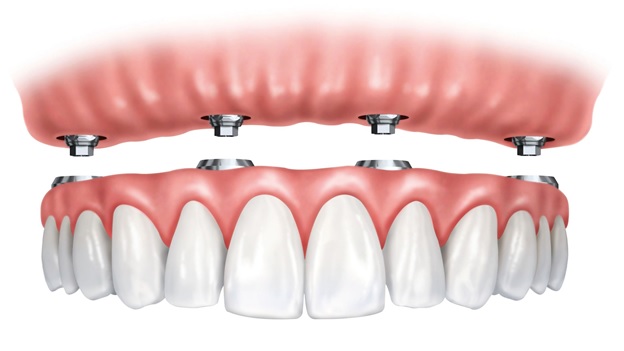The risks and problems associated with all-on-4 dental treatment can worry anyone interested in undergoing the procedure. As this type of implant procedure is becoming increasingly popular, more and more “problems” arise. However, as with any medical procedure, there are risks that all patients should fully understand before using. A reliable dentist provides the information you need to make the best decision for you.

What is All-on-4?
The term refers to a specific type of dental implant that replaces the entire dental arch in one procedure. This process is carried out at once and can fully restore a smile. During the procedure, dentists remove the teeth in this area and then put in a full bridge. It can be done on the upper and lower teeth, although some patients may have both performed at the same time.
What are the Risks Associated with All-on-4 Dental Implants?
Many patients have a high success rate with All-on-4 – and that’s good. However, here are some key issues you may face.
Risk Related to Anaesthesia
The type of anaesthesia depends on the dental practice and the individual needs of the patient. There are several options such as mild anaesthesia that works well for less nervous people. Some people may want to sleep during the procedure. In this case, it’s important to have a trusted anesthesiologist at your disposal. When choosing, dentists and patients must consider the following:
- What is the minimum amount of anaesthesia to make you feel comfortable?
- Does the patient have pre-existing conditions that can make one form of anaesthesia less desirable than another?
- What experience has the patient had with anaesthesia in the past?
Anaesthesia problems are rare and it is unlikely that patients and dentists won’t be on the same page about the necessary and available care.
Implant Failure
There is a risk that all-on-4 dental implants will fail. This happens in about 5% of patients and occurs when implants do not attach to the bone. It is not always clear why this happens, which is frustrating for everyone involved. Usually, this can be remedied with a new implant. Reducing this risk has been difficult since the dentist, and researchers don’t always know why one implant fails and others don’t. However, if the patient adheres to all care instructions before and after tooth implantation, the likelihood is lower. This means maintaining oral hygiene, eating soft foods and avoiding smoking.
Risk of Infection
Any type of surgery carries the risk of infection. Good dentists do everything possible to minimise this risk. However, infections occur for a variety of reasons. One of the most common results is the presence of peri-implantitis. Get help quickly if you notice the following:
- Dental implants are loose or wobbly
- Bad breath
- Bad taste in the mouth
- Gums are swollen, red, and inflamed around dental implants
- Pus occurs in the gums
- Excessive bleeding when brushing
You can also reduce the risk by following the steps of the dentist to keep new implants after surgery. This includes not drinking alcohol, smoking and following specific oral hygiene steps that have been provided to you. This can reduce the risk of infection more than anything else.
Recent Posts
- Castor Oil For Better Hair Growth: Is It Myth Or Fact?
- Exploring the Differences Between Sermorelin, Ipamorelin, Ibutamoren, GHRP2, and GHRP6: Understanding Their Role in Human Growth Hormone Regulation
- Unraveling the Mystery: Understanding the Causes and Prognosis of Ventricular Tachycardia Without Apparent Heart Disease
- Understanding Grandparents’ Rights in Oklahoma: Navigating Visitation and Legal Protections
- 10 Reasons to Consider Hypnotherapy for Your Health

